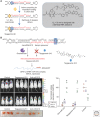Drugging the RNA World
- PMID: 30385607
- PMCID: PMC6211391
- DOI: 10.1101/cshperspect.a034769
Drugging the RNA World
Abstract
Although we live in the remnants of an RNA world, the world of drug discovery and chemical probes is firmly protein-centric. Developing highly selective small molecules targeting RNA is often considered to be an insurmountable challenge. Our goal is to demystify the design of such compounds. In this review, we describe various approaches to design small molecules that target RNA from sequence and the application of these compounds in RNA biology, with a focus on inhibition of human RNA-protein complexes. We have developed a library-versus-library screening approach to define selective RNA-small-molecule binding partners and applied them to disease-causing RNAs, in particular noncoding oncogenic RNAs and expanded RNA repeats, to modulate their biology in cells and animals. We also describe the design of new types of small-molecule probes that could broadly decipher the mysteries of RNA in cells.
Copyright © 2018 Cold Spring Harbor Laboratory Press; all rights reserved.
Figures





Similar articles
-
Rational Design of Small Molecules Targeting Oncogenic Noncoding RNAs from Sequence.Acc Chem Res. 2016 Dec 20;49(12):2698-2704. doi: 10.1021/acs.accounts.6b00326. Epub 2016 Nov 22. Acc Chem Res. 2016. PMID: 27993012 Free PMC article.
-
Development of pharmacophore models for small molecules targeting RNA: Application to the RNA repeat expansion in myotonic dystrophy type 1.Bioorg Med Chem Lett. 2016 Dec 1;26(23):5792-5796. doi: 10.1016/j.bmcl.2016.10.037. Epub 2016 Oct 13. Bioorg Med Chem Lett. 2016. PMID: 27839685 Free PMC article.
-
Defining RNA-Small Molecule Affinity Landscapes Enables Design of a Small Molecule Inhibitor of an Oncogenic Noncoding RNA.ACS Cent Sci. 2017 Mar 22;3(3):205-216. doi: 10.1021/acscentsci.7b00009. Epub 2017 Mar 6. ACS Cent Sci. 2017. PMID: 28386598 Free PMC article.
-
Approaches to Validate and Manipulate RNA Targets with Small Molecules in Cells.Annu Rev Pharmacol Toxicol. 2016;56:123-40. doi: 10.1146/annurev-pharmtox-010715-103910. Epub 2015 Oct 22. Annu Rev Pharmacol Toxicol. 2016. PMID: 26514201 Free PMC article. Review.
-
Design of small molecules targeting RNA structure from sequence.Chem Soc Rev. 2020 Oct 19;49(20):7252-7270. doi: 10.1039/d0cs00455c. Chem Soc Rev. 2020. PMID: 32935689 Free PMC article. Review.
Cited by
-
Identification of RNA-Binding Proteins as Targetable Putative Oncogenes in Neuroblastoma.Int J Mol Sci. 2020 Jul 19;21(14):5098. doi: 10.3390/ijms21145098. Int J Mol Sci. 2020. PMID: 32707690 Free PMC article.
-
Biosensor-surface plasmon resonance: A strategy to help establish a new generation RNA-specific small molecules.Methods. 2019 Sep 1;167:15-27. doi: 10.1016/j.ymeth.2019.05.005. Epub 2019 May 9. Methods. 2019. PMID: 31077819 Free PMC article.
-
Designing strategies of small-molecule compounds for modulating non-coding RNAs in cancer therapy.J Hematol Oncol. 2022 Feb 5;15(1):14. doi: 10.1186/s13045-022-01230-6. J Hematol Oncol. 2022. PMID: 35123522 Free PMC article. Review.
-
Screening of Minimalist Noncanonical Sites in Duplex DNA and RNA Reveals Context and Motif-Selective Binding by Fluorogenic Base Probes.Chemistry. 2022 Jan 10;28(2):e202103616. doi: 10.1002/chem.202103616. Epub 2021 Nov 24. Chemistry. 2022. PMID: 34693570 Free PMC article.
-
Supramolecular Cylinders Target Bulge Structures in the 5' UTR of the RNA Genome of SARS-CoV-2 and Inhibit Viral Replication*.Angew Chem Int Ed Engl. 2021 Aug 9;60(33):18144-18151. doi: 10.1002/anie.202104179. Epub 2021 Jul 9. Angew Chem Int Ed Engl. 2021. PMID: 33915014 Free PMC article.
References
-
- Bevilacqua PC, Ritchey LE, Su Z, Assmann SM. 2016. Genome-wide analysis of RNA secondary structure. Ann Rev Genet 50: 235–266. - PubMed
Publication types
MeSH terms
Substances
Grants and funding
LinkOut - more resources
Full Text Sources
Other Literature Sources
